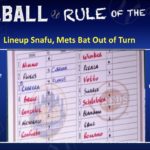NCAA 5-5 Substitutions
Substitutions
SECTION 5. a. Each team shall have nine eligible players in the game at all times.
b. Any pitcher may be replaced after the first opposing batter (or the batter’s substitute) has been put out or has advanced to first base or the side has been retired. In case of injury or illness, a pitcher may be replaced immediately (see 9-4-c-1).
Note 1: When a pitcher is removed as a pitcher but remains in the game, the individual may return to the mound only once (see 7-2-c-5, 9-4-b and 9-4-e) if not in conflict with 9-4-b.
Note 2: A substitute becomes a player when he has been reported to the umpire-inchief and the new player is written into the umpire-in-chief’s lineup card.
Note 3: If a pitcher is brought into the game but has not faced one batter (or retired the side) when the game is stopped for weather, such pitcher may, but is not required to, continue pitching when the game is resumed.
Note 4: No player removed for a substitute before the suspension of play may return to the lineup when the game is resumed.
c. Any player other than the pitcher may be substituted for at any time when the ball is dead, and the substituted player must take the place of the replaced player in the team’s batting order (see 5-5-e and 6-5-d Note)
Note: If the pitcher is removed from the game as a pitcher, but will remain in the game and bat for the DH, that change must be announced at the time the pitcher is removed.
d. The designated hitter may enter the game on defense once but must bat in the original position in the lineup. The pitcher must then bat in the position vacated by the player leaving the game (see 7-2-d-5-b).
e. If two or more substitute players of the defensive team enter the game simultaneously, the coach or a representative immediately shall designate to the umpire-in-chief the position of each in the team’s batting order. If this is not done immediately, the umpire shall place them in the batting order.
Note: When the pitcher is not the designated hitter, moving the pitcher to a defensive position and bringing in only one new substitute player does not constitute multiple substitution for the purpose of batting-order changes. The pitcher moved to the defensive position must bat in the spot of the defensive player replaced and the new pitcher must bat in the DH position.
f. A base runner shall not be replaced by another player whose name appears or has appeared in the batting order for that game.
PENALTY for f.—If the illegal pinch runner is on base when appealed, the player is declared out and is disqualified from the game. If the runner has scored a run and the appeal is made before the first pitch to the next batter, the player is declared out, the run is canceled and the player is disqualified from the game. Any advancement by other runners is legal. If the illegal pinch runner is the third out, no succeeding runners can score.
g. After having been notified or confirmed by the head coach or another coach in uniform of the team making the substitution, the umpire shall record any substitutions on the lineup card and then announce immediately or cause to be announced any substitutions. Should there be no announcement of substitution, the substitute becomes a legal player when: 1) A runner takes the place of another base runner; 2) A pitcher engages the pitcher’s rubber; 3) A fielder reaches the position usually occupied by the fielder being replaced and play commences; or 4) A batter enters the batter’s box.
Note: Any play made by, or on, any of the above-mentioned unreported substitutes shall be legal. There is no penalty.
h. If a player substitutes for an injured teammate, other than the pitcher, the individual shall be allowed five warm-up throws.
i. A withdrawn player may sit on the bench, warm up pitchers and act as a base coach.
j. Should a withdrawn (disqualified) player re-enter the game:
1) If on offense, whether as a batter or a runner, upon discovery by the opposing team or an umpire, the player immediately shall be declared out and disqualified from the game. If the player should score a run before the discovery, an appeal must be made to the umpire-in-chief before the first pitch to the next batter of either team. This appeal would invalidate the action of the ineligible player;
2) If on defense, the disqualified player shall be replaced immediately upon discovery by the opposing team or an umpire. If a play should precede the discovery, and the discovery is appealed to the umpire-in-chief before the first pitch to the next batter of either team, the team on offense has the option to let the play stand or require the batter to bat again, with the ball-strike count before the last pitch; or
3) Any player for whom a withdrawn player substitutes may not re-enter the game.



